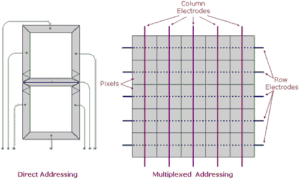The development of the twisted nematic liquid crystal (TNLC), with its 90° twist, made the production of commercially viable LCDs possible. Though relatively cheap to make and requiring very little power (hence their use in watches, calculators, etc.), there are problems associated with using TNLCDs in larger, more complex displays.
In calculator type displays, each segment which makes up the characters can be directly driven, or addressed, ensuring that each segment receives the correct amount of voltage required to cause it to change orientation. This is important with TNLCs because the voltage switching range (the difference between the voltage at which the cell changes from on to off and that at which they change from off to on) is quite large.
More complex displays need to use matrix addressing, where each pixel sits at the junction of two addressing lines and the cell is only switched if both lines have current flowing through them. In matrix addressed LC displays, the switching voltage range needs to be much smaller, making it impractical to use TNLCs. Passive matrix addressed LCDs are referred to as multiplexed LCDs. Multiplexed TNLCDs tend to have drastically reduced contrast ratios, which can be greater than 100:1 in direct drive applications but drop to around 5:1 in multiplexed addressed displays.
In the early 1980’s, Nehring and Scheffer, using computer simulations, came up with the super twisted nematic liquid crystal (STNLC) which has a twist of over 180°, typically between 210° and 270°. This, somewhat surprisingly, causes the STNLC chains to have a much smaller voltage switching range. They also produce a display with a much better contrast ratio, a better viewing angle and their degree of twist is much easier to control, giving them quite good grey-scale properties. There are disadvantages, though. Their response time (the time it takes to go from on to off or off to on) is slower than TNLCs, about 200 milliseconds as opposed to about 60 milliseconds, they are not as bright and are more expensive to manufacture. These disadvantages were minor, though, considering that, for the first time, it was practical to produce an LCD which could be fitted to a portable computer.
Another disadvantage of early STNLCDs was that they tended to produce blue and yellow images, rather than black and white ones. It was discovered that placing a second layer of STNLCs above the first, with the STN chains twisted in the opposite direction, a display which produced a true black and white image, which, with the addition of coloured filters meant a colour display, could be produced. This type of display with the double layer of STNLCs was, not surprisingly, given the name double super twisted nematic LCD or DSTNLCD. These displays were, obviously, much thicker, heavier and more expensive to manufacture and when it was discovered that the same effect could be achieved by using a compensation film to produce a thinner, lighter and cheaper STN display, the film-compensated STNLCD (FSTNLCD) was developed.
Technology has moved on quite a bit since the development of the STN, but the low production cost of STNLCDs means that they have not been forgotten. Improvements are still being made to their contrast ratios, viewing angles and response times. Other factors, such as cross-talk, which occurs when cells are affected by the switching of those adjacent to them, are also being addressed (no pun intended) by companies such as Asahi, Sanyo and Sharp.

